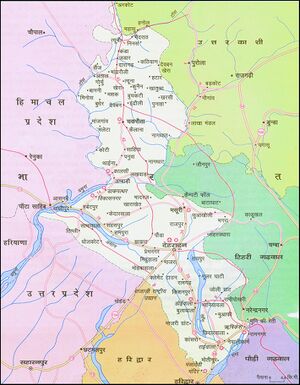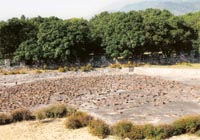Jagatgram
| Author:Laxman Burdak, IFS (R) |


Jagatgram is an ancient village in Dehradun district of Uttarakhand. It was the capital of Pona king Silavarman. Pona has been identified as Punia clan of Jats by Bhim Singh Dahiya[1].
Variants
- Jagatagrama (जगतग्राम) दे. देहरादून (AS, p.352)
- Jagatigram
Location
Origin of name
Jat clan
History
Jat History
Bhim Singh Dahiya[2] writes: The people called Paunikas (Paunas) are mentioned in Vayu Purana. They were ruling near Jagadhari on the Yamuna river and their epigraph has been found at Jagatgram near Chuhadpur in Dehradun district. [3]
Archaeological Survey of India tells that Jagatgram ancient site was excavated by, ASI between the year 1952 - 54. Excavations revealed remains of three fire alters and other associated material include inscribed bricks. These fire alter known as Syena chiti in form of flying Eagle shaped belongs Ashvamedha sacrifices perform by their authors. Sanskrit inscriptions in the late third century AD Brahmi characters on bricks used in one of the three Jagatgram altars inform that the king Silavarman, alias Pona, of Yugasaila, who belonged to the Vrishagana gotra, performed four Asvamedha sacrifices here. Obviously during the third century AD at least western part of Central Himalaya was known as Yugasiala. In Pan Indian context such altars are extremely rare. [4]
Vrisha (वृष) is one of the name of Shiva mentioned in Aswamedha Parva, Mahabharata/Book 14 Chapter 8 verse (XIV.8.19)[5]
Dinesh Prasad Saklani[6] writes that ....We have evidences to show the architectural knowledge of the early historic people in the form of sacrificial structure, the remains of which are in the shape of bricks of recognizable measurements at Jagatgram. The second site from the same place brought out a number of inscribed bricks. The third site yielded the relics of another structure related to horse sacrifice in the shape of bricks. Those bricks are arranged in triangular, oblong and squire plans for building an eagle-shaped altar. The bricks have different names to distinguish them.
The paleographical study also assigns the inscribed bricks a date of about 3rd-4th century. Ramchandran attributed that site to the Yaudheya dynasty, to which according to him, the King Silavarman might have belonged. p.163
Dinesh Prasad Saklani[7] writes that ....Another hypothesis has been forwarded else where that the King Silavarman probably belonged to Singhapura, mentioned in the Lakhamandala prasati.
Dinesh Prasad Saklani[8] writes that the Khasas, Kunindas and Yaudheyas etc had a democratic republican form of political system in ancient times.
Archaeological Survey of India[9] places Silavarman as a post-Kushan and pre-Gupta king, i.e., between A.D. 250 and 300.
Omacanda Hāṇḍā[10] states that the burnt brick yjnashala platform made of inscribed burnt brick at Jagatigram near Kalsi, a little away on the left bank of Yamuna assigned to the 3rd century AD, also indicates that this place remained a capital centre of a kingdom under Shilavarman.
Nothing can be stated as regards to Shilavarman, a Buddhist monk, who wrote the story of spread of Buddhism in Tibet. We can not say that Shilavarman is same as the Kamalashila, but neither can we deny it. [11]
देहरादून
विजयेन्द्र कुमार माथुर[12] ने लेख किया है ...देहरादून (AS, p.452) उत्तरी भारत के पश्चिमोत्तर उत्तराखंड राज्य में स्थित है। देहरादून शब्द की उत्पत्ति दो शब्दों को मिलाकर हुई है- देहरा शब्द का अर्थ निवास स्थान या डेरा है। दून का अर्थ द्रोण या पर्वत घाटी है। देहरादून की स्थापना 1699 में हुई थी। कहते हैं कि सिक्खों के गुरु रामराय किरतपुर पंजाब से आकर यहाँ बस गए थे। मुग़ल सम्राट औरंगज़ेब ने उन्हें कुछ ग्राम टिहरी नरेश से दान में दिलवा दिए थे। यहाँ उन्होंने 1699 ई. में मुग़ल मक़बरों से मिलता-जुलता मन्दिर भी बनवाया जो आज तक प्रसिद्ध है। शायद गुरु का डेरा इस घाटी में होने के कारण ही इस स्थान का नाम देहरादून पड़ गया होगा।
इसके अतिरिक्त एक अत्यन्त प्राचीन किंवदन्ती के अनुसार देहरादून का नाम पहले द्रोणनगर था और यह कहा जाता था कि पाण्डव-कौरवों के गुरु द्रोणाचार्य ने इस स्थान पर अपनी तपोभूमि बनाई थी और उन्हीं के नाम पर इस नगर का [p.453]: नामकरण हुआ था।
एक अन्य किंवदन्ती के अनुसार जिस द्रोणपर्त की औषधियाँ हनुमान जी लक्ष्मण के शक्ति लगने पर लंका ले गए थे, वह देहरादून में स्थित था, किन्तु वाल्मीकि रामायण में इस पर्वत को महोदय कहा गया है।
यह भी कहा जाता है कि महाभारत काल में विराटराज की सेना कालसी में रहा करती थी, जो देहरादून के पास ही है और उनकी गाँवों की रक्षा छद्मवेशधारी अर्जुन ने की थी। (इस पिछली किंवदन्ती में कुछ भी तथ्य नहीं जान पड़ता क्योंकि विराट का राज्य मत्स्यदेश में था, जो वर्तमान अलवर-जयपुर का इलाक़ा है।) देहरादून का एक अति प्राचीन मुहल्ला खुरवाड़ा है, जिसका सम्बन्ध लोक कथा में विराट के गौऔं के खुरों के गिरने से जोड़ा जाता है।
देहरादून ज़िले में कालसी के निकट जगतग्राम नामक स्थान पर तृतीय शती ई. के कुछ अवशेष मिले हैं, जिनसे ज्ञात होता है, कि राजा शीलवर्मन ने इस स्थान पर अश्वमेध यज्ञ किया था। इससे यह महत्त्वपूर्ण तथ्य सिद्ध होता है कि देश के इस भाग में तृतीय शती ई. में हिन्दू धर्म के पुनर्जागरण के लक्षण निश्चित रूप से दिखाई पड़ने लगे थे।
मुग़ल साम्राज्य के छिन्न-भिन्न हो जाने पर 1772 ई. में देहरादून पर गूजरों ने आक्रमण किया था। तत्पश्चात् अफ़ग़ान सरदार ग़ुलाम क़ादिर ने गुरु रामराय के मन्दिर में अनेक हिन्दुओं का वध किया और फिर सहारनपुर के सूबेदार नजीबुद्दौला ने दून-घाटी पर आक्रमण करके उस पर अधिकार कर लिया। उसकी मृत्यु के पश्चात् गूजर, राजपूत और गोरखे; इन सभी ने बारी-बारी से इस प्रदेश में लूटमार मचाई।
1783 ई. में सिख सरदार बघेल सिंह ने सहारनपुर को लूटने के पश्चात् देहरादून को नष्ट-भ्रष्ट कर दिया। जिन लोगों ने रामराय के मन्दिर में शरण ली, केवल वे ही बच सके अन्य सब को तलवार के घाट उतार दिया गया। आसपास के गाँवों में भी बघेल सिंह के सैनिकों ने लूट-मार मचाई।
1786 ई. में ग़ुलाम क़ादिर ने दुबारा देहरादून को लूटा और इस बार उसका सहायक मनियार सिंह भी था। ग़ुलाम क़ादिर ने रामराय के गुरुद्वारे को लूटकर जला दिया और बिछी हुई गुरु की शैया पर शयन कर उसने सिक्खों और हिन्दुओं के हृदयों को भारी ठेस पहुँचाई। स्थानीय हिन्दुओं का विश्वास था कि इन्हीं अत्याचारों के कारण यह दृष्ट आक्रांता पागल होकर मृत्यु को प्राप्त हुआ।
1801 ई. में गोरखों ने दून घाटी को हस्तगत कर लिया। यहाँ उस समय टिहरी गढ़वाल नरेश प्रदुम्नशाह का अधिकार था। इस लड़ाई में गोरखा नरेश बहादुरशाह का वीर सेनानी अमर सिंह ने बड़ी वीरता से सामना किया। गोरखों का राज्य इस घाटी में तेरह-चौदह वर्ष तक रहा। इस काल में उन्होंने बड़ी नृशंसता से शासन किया। उनका अत्याचार यहाँ तक बढ़ गया था कि वे लगान वसूल करने के लिए किसानों को प्रतिवर्ष हरिद्वार के मेले में बेच दिया करते थे। कहा जाता है कि इनका मूल्य दस से एक सौ पचास रुपये तक उठता था। अत्याचार ग्रस्त किसान सैकड़ों की संख्या में दून-घाटी से भागकर बाहर चले गए। रामराय गुरुद्वारे के महन्त हरसेवक ने बाद में इन किसानों को वापस बुला लिया था।
1814 ई. में गोरखा युद्ध के पश्चात् दूनघाटी तथा उत्तरी भारत के अन्य पहाड़ी प्रदेश अंग्रेज़ों के हाथ में आ गए। 18वीं सदी के दौरान आक्रमणकारियों ने एक के बाद एक इस इलाक़े पर विजय पाई, जिनमें अंतिम गुरखा थे। 1816 में गुरखा युद्ध की समाप्ति पर यह क्षेत्र अंग्रेज़ों को सत्तांतरित कर दिया गया।
References
- ↑ Bhim Singh Dahiya: Jats the Ancient Rulers (A clan study)/Jat Clan in India,p. 267
- ↑ Bhim Singh Dahiya: Jats the Ancient Rulers (A clan study)/Jat Clan in India,p. 267
- ↑ Budha Prakash,Studies in Indian History and Civilization, p.263
- ↑ Archaeological Survey of India, Dehradun Circle, Uttarakhand
- ↑ पशूनां पतये चैव भूतानां पतये तदा, वृषाय मातृभक्ताय सेनान्ये मध्यमाय च (XIV.8.19)
- ↑ Ancient Communities of the Himalaya By Dinesh Prasad Saklani, Indus Publishing Co., FS-5, Tagore Garden, New Delhi-110027, p.163
- ↑ Ancient Communities of the Himalaya By Dinesh Prasad Saklani, Indus Publishing Co., FS-5, Tagore Garden, New Delhi-110027, p.164
- ↑ Ancient Communities of the Himalaya By Dinesh Prasad Saklani, p.176
- ↑ Indian Archaeology 1953-54 A Review - Archaeological Survey of India
- ↑ History of Uttaranchal By Omacanda Hāṇḍā,p.106
- ↑ The Tombs of the Tibetan Kings By Giuseppe Tucci,
- ↑ Aitihasik Sthanavali by Vijayendra Kumar Mathur, p.452-453

